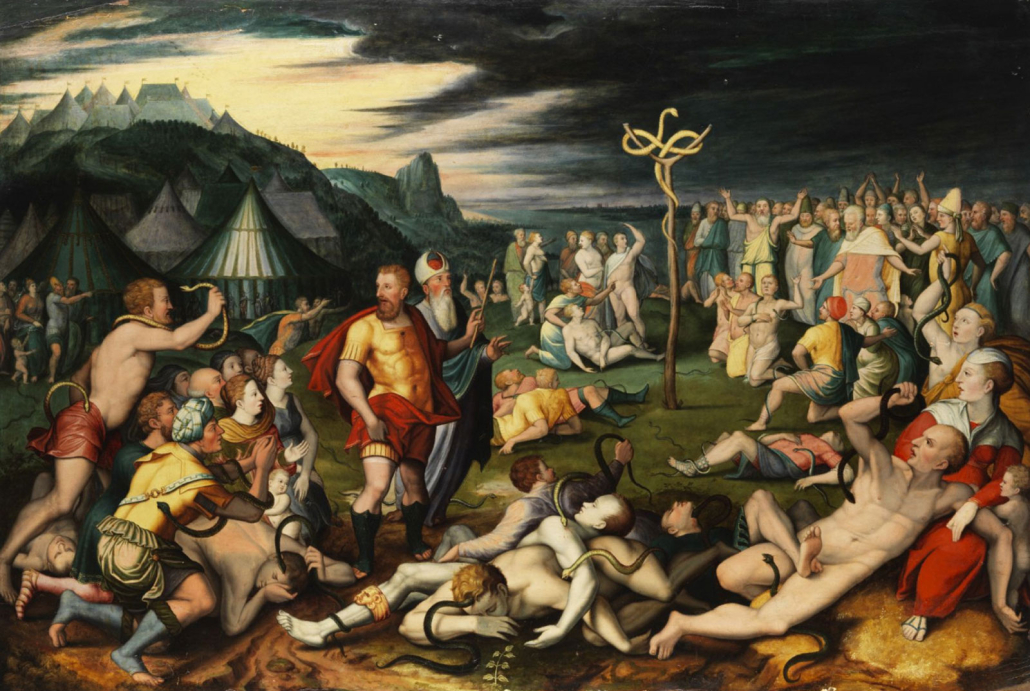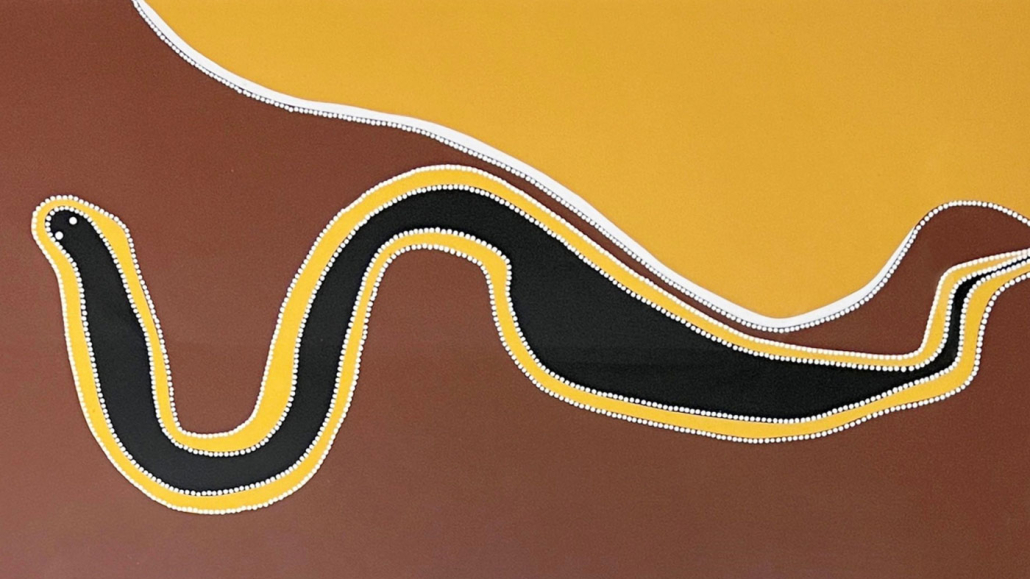Image: Rover Thomas, ‘Rainbow Serpent’, 1996, Screen print, 48.5 x 91 cm 74 x 112 cm.
‘An icon of snake and seraph’
Andrew Collis
Lent 4, Year B
Numbers 21:4-9; Psalm 107:1-3,17-22); Ephesians 2:1-10; John 3:14-21
“As Moses lifted up the serpent in the desert, so the Chosen One must be lifted up, so that everyone who believes in the Chosen One might have eternal life” (John 3:14-15).
The Book of Numbers includes a story about the Israelites in the desert. Over 40 years, they experience exhilaration, frustration, confusion … longing, hoping … grumbling, blaming … Their leader, Moses, mediates divine teaching and providence.
Toward the end of the 40-year period, after waging a war and setting fire to a town and country, the people experience the terror of “fiery serpents”. The venomous snakes are described as agents of divine punishment. The remedy to the infestation, God tells Moses, entails lifting a bronze serpent upon a pole. When the afflicted see the image, they experience healing.
How we see the story depends to some extent on how we see the snakes.
The Hebrew text uses the word, saraph, akin to seraphim, elsewhere awe-inspiring angels. Cobras and/or flying fiery serpent-angels …
Biblical scholar Anthony Rees writes: “The snake is a highly ambiguous character in this text. It starts as an agent of punishment, reinforcing the image that we have of snakes as a natural enemy to humanity. But in the manufacture of a magical healing snake, that stereotype is undermined. The snake, known for its power to kill and so to create fear and animosity, ironically becomes an image which gives life.”
Rees reads the text ecologically, linking various episodes, accounts of war and destruction of habitat. The folly of a war-mongering people.
Instructed to gaze upon the bronze serpent, the people of God see what they have done to harm their neighbours, the earth and its creatures, namely snakes. Acknowledgement leads to understanding, which leads to wisdom and healing.
The chapter ends with the Israelites receiving a gift of precious water.
The people of God may see a lot more. They may see Egyptian iconography, Midianite and Canaanite (bush) medicine … the snake (Rainbow Serpent) as emblem of renewal and transformation …
The snake figure was associated with Asclepius, the Greek god of medicine. It was believed to be able to cure a patient or a wounded person by touch alone. The snake relates to pharmacology and antisepsis, as snakes possess an antivenom against their own poison.
The people of God may recall the Greek story of Hermes upon whose wand two serpents entwine – a symbol of healing and peace (caduceus) – a contemporary icon associated with ambulance services and chemist shops the world over. Hermes, the messenger god, figures hermeneutics, the art of interpretation, poetics – communication, translation and other processes of encounter.
The gospel of John presents Jesus as the Chosen One, the Human or Angelic Being whose lifting up is both terrible and beautiful.
The crucifixion – or crucifix – invites contemplation, imaginative and existential engagement, ideological and ecological engagement … We may come to see what we have done – behold the one we have rejected, subjected to torture – what we are doing to harm our neighbours, the earth and its creatures …
Acknowledgement leads to understanding, which leads to wisdom (repentance, penitential action, more ethical and responsible practice); healing (may it be so).
The Passion itself ends with believers receiving a gift of precious water.
Christ is a kind of snake, then, a seraph, an emblem or icon of Sophia/Wisdom.
Contemplation of Christ offers a kind of inoculation. The icon of snake and seraph invites our steady gaze, close/poetic reading.
So don’t look away, tempted to immature grumbling, blaming; projecting immature desires for punishment and reward; pulled back into violence and destruction. Freedom calls.
Look at what you have done. Look at what has happened, is happening, all around you. Appreciate the beauty of stories and symbols, diverse cultures. Understand the religion/s of fear and control. Begin again.
The snake is not simply a danger but a fellow creature with its own needs and desires; with wisdom to share.
The seraph, Sophia, might become a spiritual companion … one with whom to practise freedom, the religion of creativity and compassion. “Yes, God so loved the world …”
And once you have seen this snake and seraph, you will not so easily be frightened, manipulated. Freedom transforms.
Your vision renewed (born again), you may even experience the gospel promise: an experience of the lowly as highly ambiguous/valuable; an experience of the inglorious as glorious.
The psalmist sings: “‘Give thanks for Adonai’s goodness;/ God’s love endures forever!’/ Let these be the words of Adonai’s redeemed,/ those redeemed from the oppressor’s clutches …”
And the letter to the Ephesians affirms our becoming an icon of snakes and seraphim:
“God raised us up and, in union with Christ Jesus, gave us a place in the heavenly realm, to display in ages to come how immense are the resources of God’s grace and kindness in Christ Jesus … We are God’s work of art, created in Christ Jesus to do the good things God created us to do from the beginning” (Ephesians 2:6ff.). Amen.

Image: ‘Moses and the Brass Serpent’, oil on oakwood, 17th century, anonymous Flemish painter.



